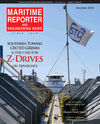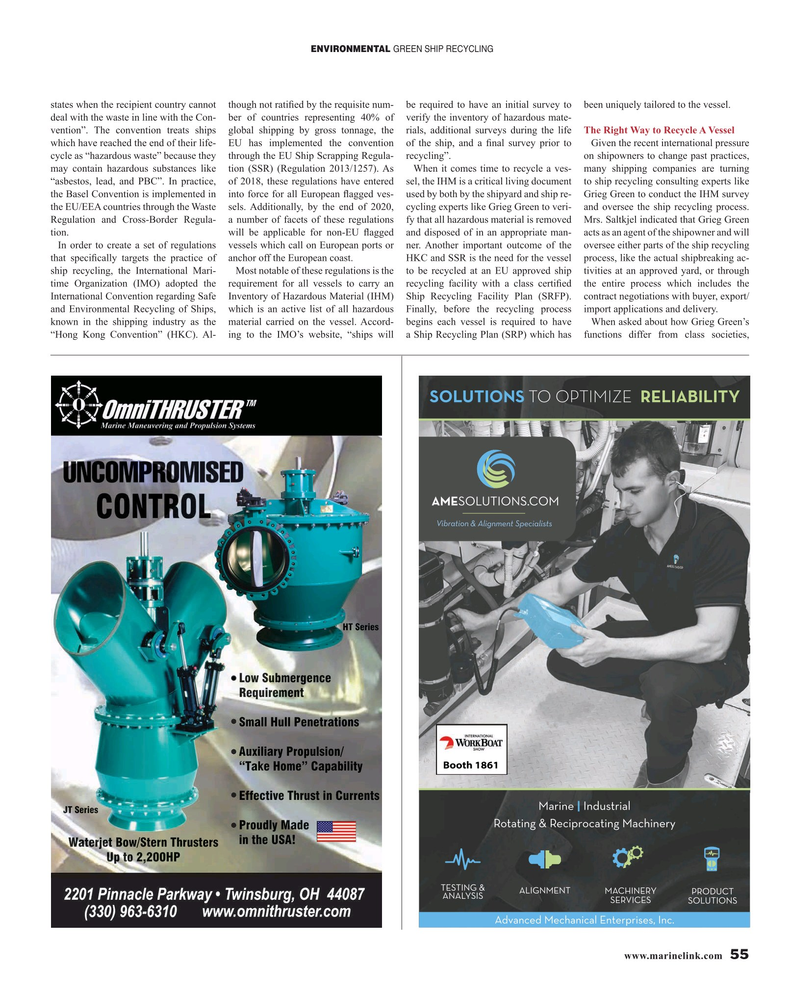
Page 55: of Maritime Reporter Magazine (November 2019)
Workboat Edition
Read this page in Pdf, Flash or Html5 edition of November 2019 Maritime Reporter Magazine
ENVIRONMENTAL GREEN SHIP RECYCLING states when the recipient country cannot though not rati? ed by the requisite num- be required to have an initial survey to been uniquely tailored to the vessel. deal with the waste in line with the Con- ber of countries representing 40% of verify the inventory of hazardous mate- vention”. The convention treats ships global shipping by gross tonnage, the rials, additional surveys during the life The Right Way to Recycle A Vessel which have reached the end of their life- EU has implemented the convention of the ship, and a ? nal survey prior to Given the recent international pressure cycle as “hazardous waste” because they through the EU Ship Scrapping Regula- recycling”. on shipowners to change past practices, may contain hazardous substances like tion (SSR) (Regulation 2013/1257). As When it comes time to recycle a ves- many shipping companies are turning “asbestos, lead, and PBC”. In practice, of 2018, these regulations have entered sel, the IHM is a critical living document to ship recycling consulting experts like the Basel Convention is implemented in into force for all European ? agged ves- used by both by the shipyard and ship re- Grieg Green to conduct the IHM survey the EU/EEA countries through the Waste sels. Additionally, by the end of 2020, cycling experts like Grieg Green to veri- and oversee the ship recycling process.
Regulation and Cross-Border Regula- a number of facets of these regulations fy that all hazardous material is removed Mrs. Saltkjel indicated that Grieg Green tion. will be applicable for non-EU ? agged and disposed of in an appropriate man- acts as an agent of the shipowner and will
In order to create a set of regulations vessels which call on European ports or ner. Another important outcome of the oversee either parts of the ship recycling that speci? cally targets the practice of anchor off the European coast. HKC and SSR is the need for the vessel process, like the actual shipbreaking ac- ship recycling, the International Mari- Most notable of these regulations is the to be recycled at an EU approved ship tivities at an approved yard, or through time Organization (IMO) adopted the requirement for all vessels to carry an recycling facility with a class certi? ed the entire process which includes the
International Convention regarding Safe Inventory of Hazardous Material (IHM) Ship Recycling Facility Plan (SRFP). contract negotiations with buyer, export/ and Environmental Recycling of Ships, which is an active list of all hazardous Finally, before the recycling process import applications and delivery. known in the shipping industry as the material carried on the vessel. Accord- begins each vessel is required to have When asked about how Grieg Green’s “Hong Kong Convention” (HKC). Al- ing to the IMO’s website, “ships will a Ship Recycling Plan (SRP) which has functions differ from class societies,
SOLUTIONS TO OPTIMIZE RELIABILITY
Booth 1861
Marine | Industrial
Rotating & Reciprocating Machinery
TESTING &
ALIGNMENT MACHINERY PRODUCT
ANALYSIS
SERVICES SOLUTIONS
Advanced Mechanical Enterprises, Inc.
www.marinelink.com 55
MR #11 (50-57).indd 55 11/5/2019 3:58:24 PM

 54
54

 56
56
